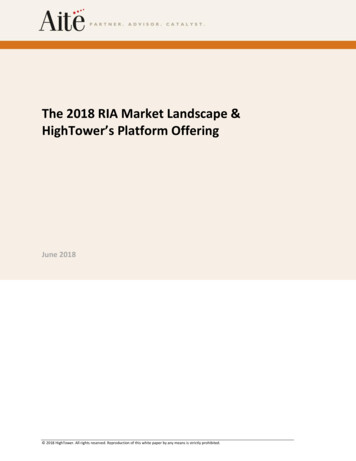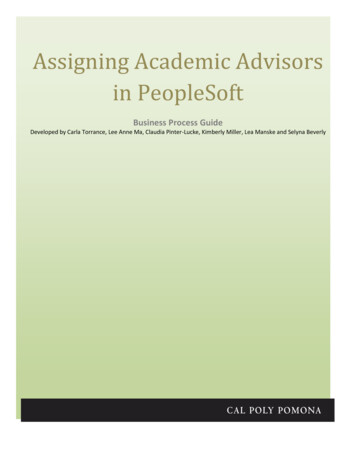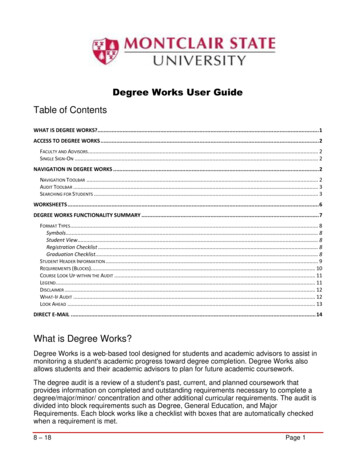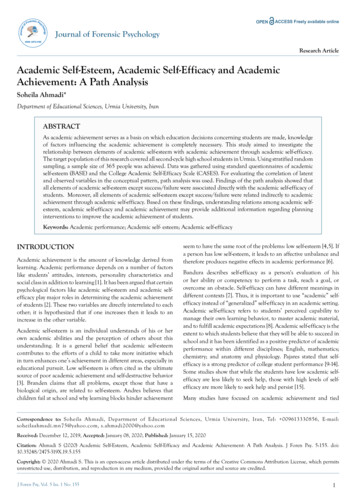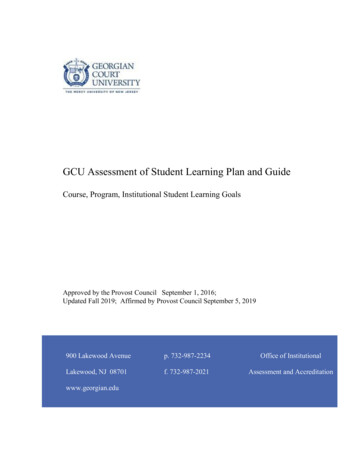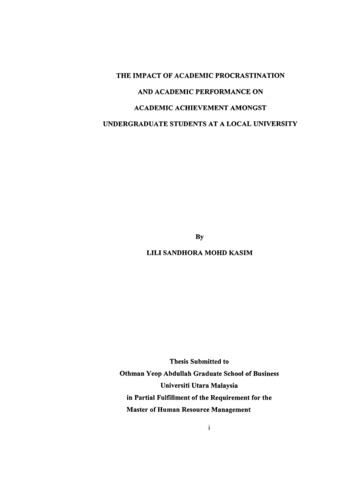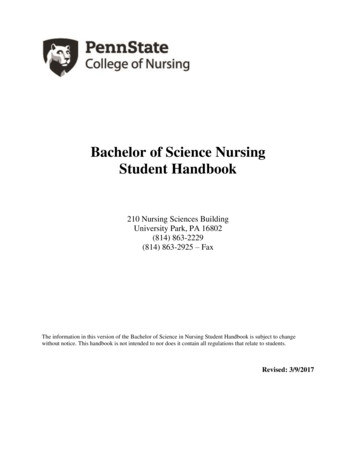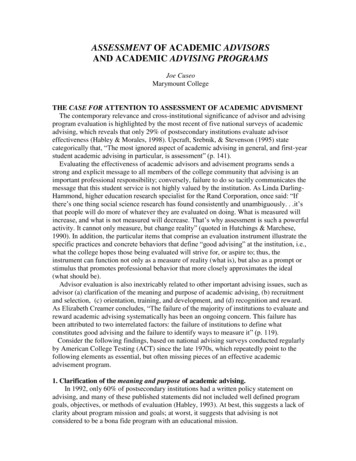
Transcription
ASSESSMENT OF ACADEMIC ADVISORSAND ACADEMIC ADVISING PROGRAMSJoe CuseoMarymount CollegeTHE CASE FOR ATTENTION TO ASSESSMENT OF ACADEMIC ADVISMENTThe contemporary relevance and cross-institutional significance of advisor and advisingprogram evaluation is highlighted by the most recent of five national surveys of academicadvising, which reveals that only 29% of postsecondary institutions evaluate advisoreffectiveness (Habley & Morales, 1998). Upcraft, Srebnik, & Stevenson (1995) statecategorically that, “The most ignored aspect of academic advising in general, and first-yearstudent academic advising in particular, is assessment” (p. 141).Evaluating the effectiveness of academic advisors and advisement programs sends astrong and explicit message to all members of the college community that advising is animportant professional responsibility; conversely, failure to do so tacitly communicates themessage that this student service is not highly valued by the institution. As Linda DarlingHammond, higher education research specialist for the Rand Corporation, once said: “Ifthere’s one thing social science research has found consistently and unambiguously. . .it’sthat people will do more of whatever they are evaluated on doing. What is measured willincrease, and what is not measured will decrease. That’s why assessment is such a powerfulactivity. It cannot only measure, but change reality” (quoted in Hutchings & Marchese,1990). In addition, the particular items that comprise an evaluation instrument illustrate thespecific practices and concrete behaviors that define “good advising” at the institution, i.e.,what the college hopes those being evaluated will strive for, or aspire to; thus, theinstrument can function not only as a measure of reality (what is), but also as a prompt orstimulus that promotes professional behavior that more closely approximates the ideal(what should be).Advisor evaluation is also inextricably related to other important advising issues, such asadvisor (a) clarification of the meaning and purpose of academic advising, (b) recruitmentand selection, (c) orientation, training, and development, and (d) recognition and reward.As Elizabeth Creamer concludes, “The failure of the majority of institutions to evaluate andreward academic advising systematically has been an ongoing concern. This failure hasbeen attributed to two interrelated factors: the failure of institutions to define whatconstitutes good advising and the failure to identify ways to measure it” (p. 119).Consider the following findings, based on national advising surveys conducted regularlyby American College Testing (ACT) since the late 1970s, which repeatedly point to thefollowing elements as essential, but often missing pieces of an effective academicadvisement program.1. Clarification of the meaning and purpose of academic advising.In 1992, only 60% of postsecondary institutions had a written policy statement onadvising, and many of these published statements did not included well defined programgoals, objectives, or methods of evaluation (Habley, 1993). At best, this suggests a lack ofclarity about program mission and goals; at worst, it suggests that advising is notconsidered to be a bona fide program with an educational mission.
22. Provision of incentives, recognition, and reward for effective academic advising.Approximately one-half of faculty contracts and collective bargaining agreementsmake absolutely no mention of advising as a faculty responsibility (Teague & Grites,1980). Less than one-third of campuses recognize and reward faculty for advising and,among those that do, advising is typically rewarded by giving it only minor considerationin promotion and tenure decisions (Habley & Habley, 1988).In a recent review of national survey findings on reward and recognition for academicadvising, Creamer & Scott (2000) reached the following conclusion: “The failure of mostinstitutions to conduct systematic evaluations of advisors is explained by a number offactors. The most potent reason, however, is probably that the traditional reward structureoften blocks the ability to reward faculty who are genuinely committed to advising” (p. 39).3. Recruitment and selection of academic advisors.Over two-thirds (68%) of postsecondary institutions surveyed have no criteria forselecting advisors (Crockett, Habley, & Cowart, 1987), suggesting an absence of attentionto professional preparedness, and failure to identify advisors who would be most qualifiedto work with high-risk students or students with special needs, such as first-generationcollege students, academically under-prepared students, undecided students, transferstudents, commuter students, and re-entry students. (Also, how often do you see academicadvising mentioned as one of the selection criteria listed in job advertisements or positionannouncements from postsecondary institutions seeking to recruit and hire new faculty?)4. Orientation, training, and development of academic advisors.Only about one-third of college campuses provide training for faculty advisors; lessthan one-quarter require faculty training; and the vast majority of institutions offeringtraining programs focus solely on dissemination of factual information, without paying anyattention to identifying the goals or objectives of advising, and the development ofeffective advising strategies or relationship skills (Habley, 1988).The upshot of all these disturbing findings is encapsulated in the following conclusionreached by Habley (2000), based on his review of findings from five national surveys ofacademic advising, dating back to 1979: “A recurrent theme, found in all five ACTsurveys, is that training, evaluation, and recognition and reward have been, and continue tobe, the weakest links in academic advising throughout the nation. These importantinstitutional practices in support of quality advising are at best unsystematic and at worstnonexistent” (p. 40).Furthermore, advisor evaluation has major implications for student satisfaction with, andretention at, the college they have chosen to attend.RATIONALE FOR THE CONTENT OF AN ADVSIOREVALUATION INSTRUMENTThe specific items that comprise the content of an advisor evaluation instrument should begrounded in research on common characteristics or qualities of advisors that students seekand value. Research repeatedly points to the conclusion that students value most highlyacademic advisors who are seen as: (1) available/accessible, (2) knowledgeable/helpful, (3)personable/approachable, and (4) counselors/mentors (Winston, Ender, & Miller, 1982;Winston, Miller, Ender, Grites, & Associates, 1984; Frost, 1991; Gordon, Habley, &Associates, 2000).Each one of these general “core” qualities of effective advisors may be defined in terms
3of more specific advisor roles and responsibilities, as follows:1) Available/Accessible: An advisor is someone who effectively communicates andinteracts with students outside the classroom, and does so more informally, morefrequently, and on a more long-term basis than course instructors. A student’s instructorswill vary from term to term, but an academic advisor is the one institutional representativewith whom the student can have continuous contact and an ongoing relationship that mayendure throughout the college experience.2) Knowledgeable/Helpful: An advisor is an effective consultant—a role that may be saidto embrace the following functions: (a) Resource Agent—one who provides accurate andtimely information about the curriculum, co-curriculum, college policies, andadministrative procedures. (b) Interpreter—one who helps students make sense of, anddevelop appreciation for the college mission, curricular requirements (e.g., the meaning,value, and purpose of general education), and co-curricular experiences (e.g., theimportance of out-of-class experiences for student learning and development). (c)Liaison/Referral Agent—one who connects students with key academic support and studentdevelopment services. (d) Teacher/Educator—one who helps students gain self-insight intotheir interests, aptitudes, and values; who enables students to see the “connection” betweentheir academic experience and their future life plans; and who promotes students’ cognitiveskills in problem-solving, decision-making, and critical thinking with respect to present andfuture educational choices.3) Personable/Approachable: An advisor is a humanizing or personalizing agent withwhom students feel comfortable seeking out, who knows students by name, and who takesa personal interest in individual students’ experiences, progress, and development.4) Counselor/Mentor: An advisor is an advocate who students can turn to for advice,counsel, guidance, or direction; who listens actively and empathically; and who responds tostudents in a non-judgmental manner—treating them as clients to be mentored—rather thanas subordinates to be evaluated (or graded).These four advisor roles can be used to generate related clusters of advisor characteristicsor behaviors that represent the content (rating items) of an advisor evaluation instrument.An example of such an instrument is provided in Appendix A (pp. 15-17). While theforegoing synthesis of advisor roles may be useful for guiding construction of specificitems on the advisor evaluation instrument, the scholarly literature on academic advisingstrongly suggests that advisor evaluation should originate with, and be driven by, a clearmission statement that reflects consensual or communal understanding of the overarchingmeaning and purpose of the academic advisement program (White, 2000). This statementof program purpose should be consistent with, and connected to the college missionstatement, thus underscoring the centrality of the advisement program and its pivotal role inthe realization of broader institutional goals. Kuh, Schuh, Whitt, and Associates (1991)report from campus visits that connection between program purpose and institutionalmission characterizes educational program delivery at “involving” colleges, i.e., collegeswith a strong track record of actively engaging students in the college experience. As theyput it, “Policies and practices at Involving Colleges are effective because they are missiondriven and are constantly evaluated to assess their contributions to educational purposes”(p. 156).The purpose statement for an academic advisement program should also serve as aspringboard or launching pad that drives and directs the development of an effectiveevaluation plan. If the college does not take time to develop a carefully constructedstatement that explicitly captures the essential purpose and priorities of its advising
4program, then individual advisors may develop different conceptions and philosophiesabout what advising should be, and their individual advising practices may vary in nature(and quality), depending on what particular advising philosophy or viewpoint they hold. Infact, research indicates that there is fairly high consistency between advisors’ statedphilosophy of advising and their actual advising behaviors or practices (Daller, Creamer, &Creamer, cited in Creamer & Scott, 2000). As Virginia Gordon (1995) points out, “Mostfaculty advisors, consciously or unconsciously, approach their advisees with a basicphilosophical stance. Some believe students are totally responsible for their own actions;thus, advising contacts should always be initiated by the student. Others view themselves asresources and take initiative when students make contact and personally express a need orconcern” (p. 95).The following statements, culled from the scholarly literature on academic advising,have the potential to serve as models or heuristics that can help guide and shape theconstruction of an effective mission statement for advising programs.(a) “Developmental academic advising is . . . a systematic process based on a closestudent-advisor relationship intended to aid students in achieving educational, career, andpersonal goals through the utilization of the full range of institutional and communityresources. It both stimulates and supports students in their quest for an enriched quality oflife” (Winston, Miller, Ender, & Grites, & Associates, 1984, p. 538)(b) “The formation of relationships that assure that at least one educator has close enoughcontact with each student to assess and influence the quality of that student’s educationalexperience is realistic only through a systematic process, such as an academic advisingprogram. It is unrealistic to expect each instructor, even with small classes, to formpersonal relationships of sufficient duration and depth with each student in his or her classto accomplish this” (Winston, Miller, Ender, & Grites, & Associates, 1984, p. 538).(c) “Developmental academic advising is not primarily an administrative function, notobtaining a signature to schedule classes, not a conference held once a term, not a paperrelationship, not supplementary to the educational process, [and] not synonymous withfaculty member” (Ender, 1983, p. 10).(d) “Academic advising can be understood best and more easily reconceptualized if theprocess of academic advising and the scheduling of classes and registration are separated.Class scheduling should no be confused with educational planning. Developmentalacademic advising becomes a more realistic goal when separated from class schedulingbecause advising can then go on all during the academic year, not just during the fewweeks prior to registration each new term. Advising programs, however, that emphasizeregistration and record keeping, while neglecting attention to students’ educational andpersonal experiences in the institution, are missing an excellent opportunity to influencedirectly and immediately the quality of students’ education and are also highly inefficient,since they are most likely employing highly educated (expensive) personnel who areperforming essentially clerical tasks” (Winston, Miller, Ender, & Grites, & Associates,1984, p. 542).
5STUDENT ASSESSMENT OF ACADEMIC ADVISORS:CONSTRUCTION & ADMINISTRATION OF AN EVALUATION INSTRUMENT1. Decide on whether you want to develop an internal (“home grown”) instrument, orimport an external (“store bought”) standardized instrument from and assessmentservice or evaluation center.There are commercially developed instruments available that specifically targetevaluation of academic advising—for example: (a) The ACT Survey of AcademicAdvising (American College Testing), (b) The Academic Advising Inventory (Winston &Sander), and (c) The Developmental Advising Inventory (Dickson & Thayer). For a reviewof standardized instruments designed to evaluate academic advising, see: Srebnik (1988).NACADA Journal, 8(1), 52-62. Also, for an annotated bibliography on advising evaluationand assessment, see the following website sponsored by the National Clearinghouse forAcademic Advising, Ohio State University, and the National Academic AdvisingAssociation: www.uvc-ohio-state.edu/chouse.htmlStandardized instruments do come with the advantage of having already-establishedreliability and validity, as well as the availability of norms that allow for cross-institutionalcomparisons. However, if you feel that your college has unique, campus-specific concernsand objectives that would be best assessed via locally developed questions, or if you wantan instrument that will elicit more qualitative data (written responses) than the typicalquantitative data generated by standardized inventories, then it might be best to developyour own campus-specific instrument.2. Consider including more than the four rating options (strongly agree – agree –disagree – strongly disagree) that comprise the typical Likert-scale.The wider range of numerical options may result in mean (average) ratings for individualitems that display a wider spread in absolute size or value. For instance, a 6-point scalemay be superior to 4-point rating scales because the latter may yield mean ratings forseparate items which vary so little in absolute size that advisors may tend to discount thesmall mean differences between items as being insignificant and inconsequential. Forexample, with a 4-option rating scale, an advisor might receive mean ratings for differentitems on the instrument that range from a low of 2.8 to a high of 3.3. Such a narrow rangeof differences in mean ratings can lead advisors to attribute these minuscule differencessimply as random “error variance” or students' failure to respond in a discerning ordiscriminating manner.An expanded 6-point scale has the potential to produce larger mean differences acrossindividual items, thus providing more discriminating data. In fact, research on studentevaluations of course instructors does suggest that a rating scale with fewer than fivechoices tends to reduce the instrument’s ability to discriminate between satisfied anddissatisfied respondents, while a rating scale with more than seven choices does not add tothe instrument’s discriminability (Cashin, 1990).In addition to providing advisors with mean scores per item, they may also be providedwith the percentage of respondents who selected each response option. This statistic willreveal how student responses were distributed across all response options, thus providingadvisors with potentially useful feedback about the degree of consistency (consensus) orvariation (disagreement) among their advisees’ ratings for each item on the instrument.3. Instructions for the advisor-evaluation instrument should strongly emphasize theneed for, and importance of, students’ written comments.
6Research on student evaluations of course instructors indicates that this type of feedbackprovides the most useful information for performance improvement (Seldin, 1992).(Indeed, the findings of many years of research on students' course evaluations may bedirectly applicable to the construction and administration of advisor-evaluationinstruments. For a review of research and practice with respect to instructor evaluations,much of which can be applied to advisor evaluations, go to the following site:http//www.Brevard.edu/fyc/listserv/index/htm, scroll down to “Listserv Remarks” andclick “Joe Cuseo, 10-20-00,” Student Evaluations of College Courses.)4. Beneath each item (statement) to be rated, it is recommended that some emptyspace be provided, preceded by the prompt, “Reason/explanation for rating: . . . .”Inclusion of such item-specific prompts has been found to increase the quantity ofwritten comments student provide—and their quality, i.e., comments are more focused andconcrete because they are anchored to a specific item (characteristic or behavior)—asopposed to the traditional practice of soliciting written comments solely at the end of theinstrument—in response to a generic or global prompt, such as: “Final Comments?”(Cuseo, 2001).Furthermore, the opportunity to provide a written response to each item allows studentsto justify their ratings, and enables us to gain some insight into why the rating was given.5. It is recommend that the instrument be kept short, containing no more than 12advisor-evaluation items.For example, four 3-item clusters could be included that relate to each of the fouraforementioned qualities of highly valued advisors. It has been the author’s experience thatthe longer an instrument is (i.e., the more reading time it requires), the less time studentsdevote to writing and, consequently, fewer useful comments are provided.6. Toward the end of the instrument, students should be asked to self-assess their owneffort and effectiveness as advisees.This portion of the instrument should serve to (a) raise students’ consciousness that theyalso need to take some personal responsibility in the advisement process for it to beeffective, and (b) assure advisors that any evaluation of their effectiveness depends, at leastin part, on the conscientiousness and cooperation of their advisees. (This, in turn, mayserve to defuse the amount of threat or defensiveness experienced by advisors about beingevaluated—a feeling that almost invariably accompanies any type of professionalperformance evaluation.)7. Decide on when to administer advisor/advising evaluations to students.One popular strategy is to ask instructors of all classes that meet at popular time slots(e.g., 11 AM and 1 PM) to “sacrifice” 15 minutes of class time to administer the advisorevaluation instrument. This procedure may not be effective for a couple of reasons: (1) Itcan result in certain advisors obtaining only a small number of their advisees evaluations,because many of their advisees may not be taking classes at these times. (2) Someinstructors are resentful about giving up any class time—particularly toward the end of thesemester—to conduct an administrative task.An alternative procedure for gathering a sufficient sample of student evaluations is toprovide advisors with evaluation forms at about the midpoint of the spring term, and askthem to give each one of their advisees the form to complete as part of their pre-
7registration process for the following term. In other words, when students meet with theiradvisor to plan their course schedule for the upcoming semester, the advisor asks them tocomplete the advisor evaluation form and submit it, along with their proposed schedule ofclasses, to the Registrar’s Office. Thus, completing the advisor evaluation becomes a preor co-requisite for course registration. This should provide a strong incentive for students tocomplete the evaluation, which in turn, should ensure a very high return rate. Also, studentswould be completing their advisor evaluations at a time during the semester when they arenot completing multiple instructor (course) evaluations—which typically are administeredeither during the last week of class or during final-exam week. There is no compellingreason for students to complete advisor evaluations at the very end of the term like they docourse/instructor evaluations—which must be administered at the end of the term, becausestudents need to experience the entire course before they can evaluate it. In contrast,student interaction with advisors is a process that traverses academic terms and does nothave the same start and stop points as student interaction with course instructors.For graduating students who will not be pre-registering for an upcoming term, theycould be asked to complete their advisor evaluation as part of their graduation-applicationor senior-audit process. As for non-graduating students who do not pre-register for classesbecause they intend to withdraw from the college, they may be asked to complete anadvisor evaluation as part of their exit-interview process. (Differences in perceptions ofadvising quality reported by returning versus non-returning students may provide revealinginformation on the relationship between advising and retention.)8. Before formally adopting an evaluation instrument, have students review it, eitherindividually or in focus groups, to gather feedback about its clarity andcomprehensiveness (e.g., if critical questions about advisors or the advising processhave been overlooked).Also, consider adding an open-ended question at the end of the instrument that wouldask students to assess the assessment instrument. (This could be referred to it as “metaassessment”—the process of assessing the assessment by the assessor).Ideally, an evaluation instrument should allow students not only rate items in terms ofperceived satisfaction or effectiveness, but also in terms of perceived need or importance.In other words, students would give two ratings for each item on the instrument: (a) a ratingof how satisfied they are with that item, and (b) a rating of how important that item is tothem. The instrument could be structured to efficiently obtain both sets of ratings bycentering the item statements (questions) in the middle of the page, with a “satisfaction”rating scale to the left of the item and an “importance” scale to the right of the same item.Lee Noel and Randi Levitz, student retention researchers and consultants, have used thisdouble-rating practice to identify institutional areas with large “performance gaps”—itemsfor which students give low satisfaction ratings but high importance ratings, i.e., a largenegative score is obtained when the satisfaction rating for an item is subtracted from itsimportance rating (Noel & Levitz, 1996). If this strategy were applied to advisorevaluation, those items that reveal high student ratings on importance but low ratings onsatisfaction would provide particularly useful information. These items reflect high-prioritystudent needs that they feel are not presently being met. As such, these items represent keytarget zones for improving academic advising—which, of course, is the ultimate purpose ofassessment.Applying this satisfaction-vs.-importance rating scheme to the advisor evaluationinstrument would, in effect, enable it to co-function as a student satisfaction survey and a
8student needs assessment survey. This would be especially advantageous because it wouldallow for the systematic collection of data on student needs. Historically, institutionalresearch in higher education has made extensive use of satisfaction surveys, which aredesigned to assess how students feel about what we are doing; in contrast, comparativelyshort shrift to has been given to assessing what they (our students) need and want from us.It could be argued that satisfaction surveys represent an institution-centered (or egocentric)form of assessment, while student needs assessment is a learner-centered form ofassessment that resonates well with the new “learning paradigm” (Barr & Tagg, 1995) andthe “student learning imperative” (American College Personnel Association, 1994).9. Before formally adopting a proposed instrument, feedback should be solicited fromacademic advisors with respect to its content and structure.Broad-based feedback should help to fine-tune the instrument and redress itsshortcomings and oversights. More importantly, perhaps, this solicitation of feedback fromadvisors gives them an opportunity to provide input and provides them with a sense ofpersonal ownership or control of the evaluation process. Advisors should feel thatevaluation is something that is being done with or for them, rather than to them. In fact,“evaluation” may not be the best term to use for this process because it tends toimmediately raise a red flag in the minds of advisors. Although the terms “evaluation” and“assessment” tend to be used interchangeably by some scholars and differentially by others,it has been the author’s experience that assessment is a less threatening term which moreaccurately captures the primary purpose of the process: to gather feedback that can be usedfor professional and programmatic improvement. It is noteworthy that, etymologically, theterm “assessment” derives from a root word meaning to “sit beside” and “assist,” whereas“evaluation” derives from the same root as “value”—which connotes appraisal andjudgment of worth. (An added bonus for using the term assessment, in lieu of evaluation, isthat the former can be combined with “academic advisement” to form the phrase,“assessment of academic advisement”—a triple alliteration with a rhythm-and-rhymingring to it that should appeal to faculty with literary leanings and poetic sensibilities.)10. In addition to, or in lieu of, calculating the average (mean) student rating forindividual items on the evaluation instrument, also calculate and report thepercentages of students choosing each rating option.This statistic will reveal how student responses were distributed across all responseoptions, thus providing potentially useful information about the degree of consistency(consensus) or variation (disagreement) among student ratings for each item on theinstrument.11. Report assessment data generated by the advisor-evaluation instrument in amanner that minimizes defensiveness and promotes improvement.One procedure that may effectively reduce personal defensiveness and increaseattention to advising improvement would be to collapse data across all advisors, and use theaggregated results or composite as a focal point to steer group discussion toward the issueof how we could improve our advisement program (rather than focusing on evaluations ofindividual advisor). The focus on the program, rather than on the individual, serves todepersonalize the process and reduce the defensiveness that often accompaniesperformance evaluation. When reviewing the results with all advisors, “we” messagesshould be used to keep the focus on us (the total program/team) rather than “you” messages
9(the individual advisor). For instance, special attention could be paid to those particularitems that advisors—on average or as a whole—received the least favorable evaluations,and the question may be asked, “What could we do to improve student perceptions(satisfaction) with respect to this aspect of our advising program?” Thus. The focus is on“our” collective strengths and weakness, rather then “your” individual strengths andweaknesses.Advisors should still receive assessment summaries of their own advising, so they are ina position to see how it compares with the norm (average) for all advisors—on each itemcomprising the instrument. Thus, if an advisor deviates from the norm, it would be obviousto them and, hopefully, these discrepancies will create the cognitive dissonance or“disequilibrium” needed to motivate positive change. To this end, a panel could beorganized consisting of advisors who received particularly high ratings and positivecomments for specific items (dimensions) of advising assessed by the instrument. Theseexceptional advisors could share advising strategies that they think may have contributed tothe exceptional evaluations they received on that particular dimension of advisin
categorically that, "The most ignored aspect of academic advising in general, and first-year student academic advising in particular, is assessment" (p. 141). Evaluating the effectiveness of academic advisors and advisement programs sends a strong and explicit message to all members of the college community that advising is an

